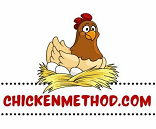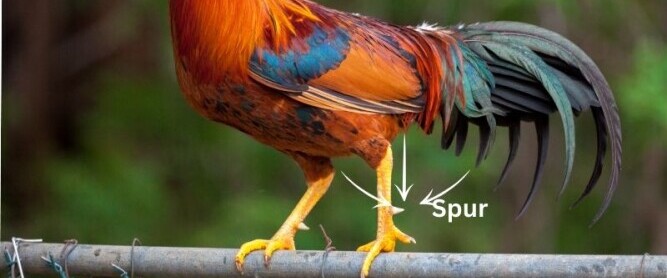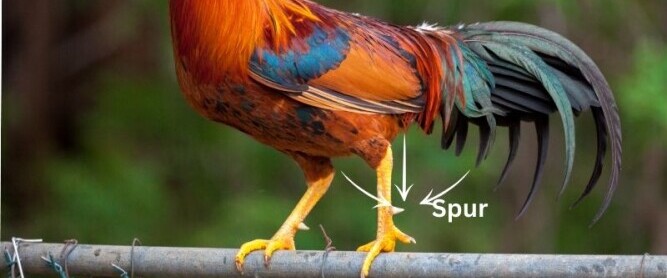
Chicken spurs are fascinating, but many don’t even know what they are. These pointy projections found on roosters’ legs and occasionally hens are more than just sharp accessories. Spurs are made of bone covered with keratin, similar to your fingernails, and they serve various purposes for chickens.
Roosters primarily have spurs, and they use them as weapons. These birds are territorial and protective of their flock, and spurs give them an edge when defending against threats.
Interestingly, not every chicken has spurs. Most hens don’t, but certain breeds and individual girls might surprise you with a set of spurs.
Speaking of breeds, the size and shape of spurs can vary widely. Some breeds are likelier to have long, curved, intimidating spurs, while others sport shorter, less dramatic ones.

Sometimes, spurs can curve back into the leg, causing lameness.
Whether big or small, spurs affect a chicken’s behavior and social hierarchy, chickens establish their pecking order based on various factors, including the presence and size of spurs.
Spurs are essentially multipurpose tools for chickens. While defense is the primary role, spurs can also be used in mating rituals and dominance displays.
Females may find males with more pronounced spurs attractive, which can signify strength and health. However, this is a double-edged sword because those large spurs can injure hens.
Overall, chicken spurs are an integral part of their anatomy and behavior. Understanding why chickens have spurs and how they use them provides valuable insight into their world. Take a closer look at your feathered friends; those spurs tell a story.
Management, Care, Trimming and Removal
Roosters, with their impressive spurs, can sometimes pose a challenge. These natural defense tools need occasional upkeep to ensure everyone’s safety – your flock’s and yours.
First up, trimming rooster spurs. Do you need to do it? Yes, sometimes. Overly long spurs can injure other chickens and even the rooster himself. So, trimming is a practical way to manage this.
There are safe methods to consider for permanently removing rooster spurs. If trimming doesn’t work, removal is often a more significant step involving a vet. Always consider what’s best for the bird’s well-being before opting for permanent removal.
Let’s talk about natural ways to manage spurs. Environmental factors like coarse perches sometimes help keep spur length in check naturally. Chickens will naturally wear down their spurs while roosting and moving around.
Not keen on trimming? That’s okay. Alternatives exist, like using a file to reduce spur length over time without a full trim. It’s a gentler approach and works well for maintenance.
Using the right tools is crucial. A good pair of pet nail clippers or a rotary tool can make the job easier and safer. Ensure you’re comfortable with the tools before starting, and remember to stop if unsure. You don’t want to injure your rooster or yourself.
Managing rooster spurs doesn’t have to be daunting. Stay calm and focused, whether trimming, filing, or naturally managing spur length. Your birds will be healthier and happier for it.
Growth and Development of Spurs
Rooster spurs grow at their own pace. Generally, you’ll notice the beginning of spur development when your rooster is around 6 to 9 months old. They start as small bumps, then grow longer and sharper over time, reaching their full potential at about one to two years.
Wondering how long it takes for a rooster’s spurs to grow? Typically, it takes several months for noticeable growth. Full-grown spurs are often seen within a year or two of age.
The rate can vary based on the breed and individual differences, but on average, that’s the timeline you’re looking at.
Will a rooster’s spur grow back if trimmed? Yes, it will. Trimming only removes part of the spur, not the base.
As time progresses, it will slowly grow back, so you’ll need to trim it periodically to manage its length safely. The regrowth rate can vary but expect to check in on it every couple of months.
Age and health can also be reflected in a rooster’s spurs. Older roosters usually have longer, more prominent spurs. A healthy bird typically shows steady spur growth. Sudden changes in spur growth could indicate health issues, so keep an eye out for anything unusual.
Understanding the growth process helps you better manage and anticipate your rooster’s needs. By keeping track of spur development and knowing what to expect, you’ll ensure a safer, happier environment for your flock.
Specially made for fowl feet, this precision tool is a low-cost must-have for your chicken-keeping tool kit.
Spur-Related Health and Safety Concerns
Spurs, while fascinating, can be a source of injury if not correctly cared for. Long spurs can harm not just other chickens but also the roosters themselves.
Injuries to the feet or legs from their own spurs can occur, especially if they get too long or sharp. Regular checks can help nip these problems in the bud.
Are spurs dangerous to other chickens or even to humans? They can be. Roosters might use their spurs during squabbles or in defense, leading to potential injuries within the flock or to caregivers. Being mindful and managing spur length can mitigate these risks significantly.
Spotting overly long spurs is pretty straightforward. If they’re curling towards the legs or seem excessively long, it’s time for a trim.
Overgrown spurs can impede movement and cause discomfort or injury to your rooster. Keeping them at an appropriate length ensures comfort and safety for everyone involved.
Sometimes, spurs can get injured or infected. If you notice swelling, redness, or your rooster favoring one leg, it could indicate a spur injury or infection. It’s essential to clean any wounds promptly and seek veterinary advice if necessary. Early intervention can prevent complications and ensure a swift recovery.
Preventing spur injuries in your flock involves regular trimming, maintaining a safe environment, and ensuring your chickens aren’t overly stressed or aggressive.
Proper handling during trims, using quality tools, and providing plenty of space can all contribute to safer spur management.
Healthy spurs mean healthy chickens. Paying attention to spur length and health is a small but vital part of keeping your flock happy. By regularly monitoring and managing spur conditions, you’re contributing significantly to their overall well-being.
Sometimes, a rooster will become aggressive and use its spurs to attack people. If this becomes an issue, it’s time to remove that rooster from your flock and your premises.
Spurs Secondary Uses and Cultural Insights
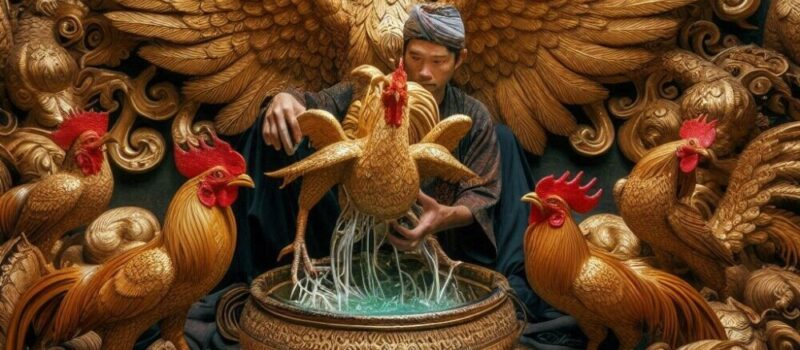
Spurs do more than provide defense. Chicken spurs have historical significance in many cultures, often symbolizing bravery and strength. Roosters with prominent spurs have been admired and used in various cultural rituals and competitions.
In various European cultures, the rooster symbolizes courage, vigilance, and masculinity. Roosters with prominent spurs are often depicted in folklore as the protectors of the farmyard, battling predators and other roosters to defend their territory.
Interestingly, hens can sometimes have spurs, too. When a hen sports spurs, it can be a genetic quirk or an indicator of higher testosterone levels. While it doesn’t happen often, it’s not unheard of, and in some breeds, it’s even a bit more common.
When it comes to ethical and legal considerations, removing spurs permanently can vary by region. Some places have strict regulations against it unless it’s for health reasons.
Ethical considerations revolve around the welfare of the bird. Always prioritize humane practices and consult local guidelines to stay compliant.
Beyond trimming and removal, there are other ways to manage spur length. Providing abrasive surfaces for your chickens to scratch can naturally wear down spurs. This more hands-off approach can be less stressful for the birds and helps keep spur length in check without direct intervention.
Finally, spurs can be indicators of age and health. Older roosters typically have longer spurs, giving you a clue about their age. Variations in spur growth can sometimes reflect overall health, so keep an eye on them as part of regular health checks.
Healthy spurs are often a sign of a healthy bird.
Whether using historical knowledge, focusing on humane management practices, or observing spurs as health indicators, there’s much more to these pointed projections than meets the eye.
Appreciating and understanding their role enhances your connection with your flock and ensures you provide the best care possible.
Thanks for stopping by,
Have you had any experience with roosters getting out of line with their spurs? I’d love to hear about it below.
Dave
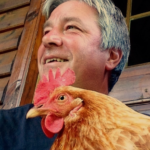
Chickenmethod.com
